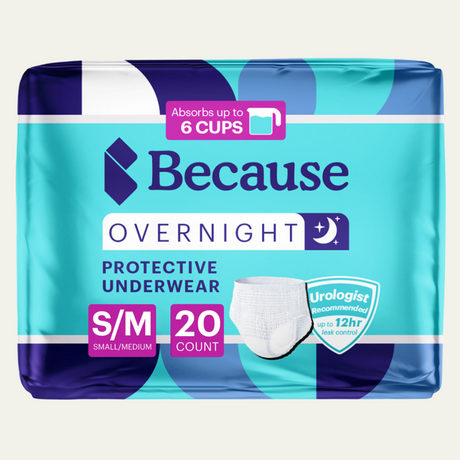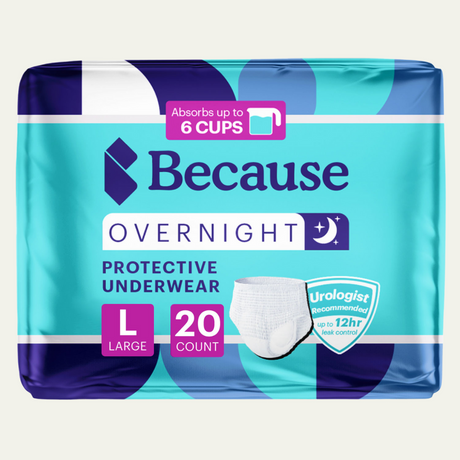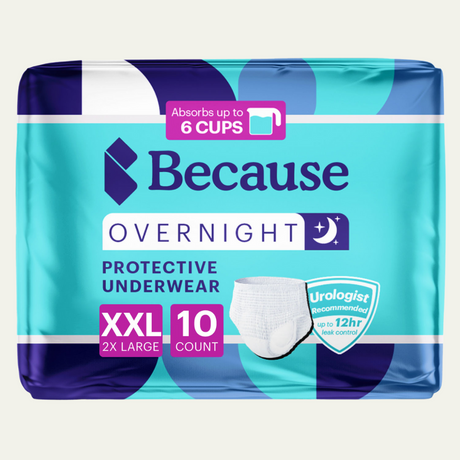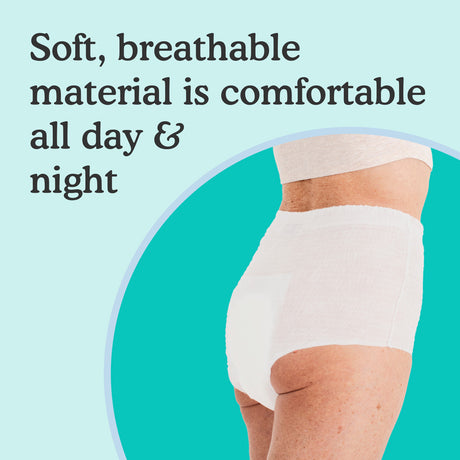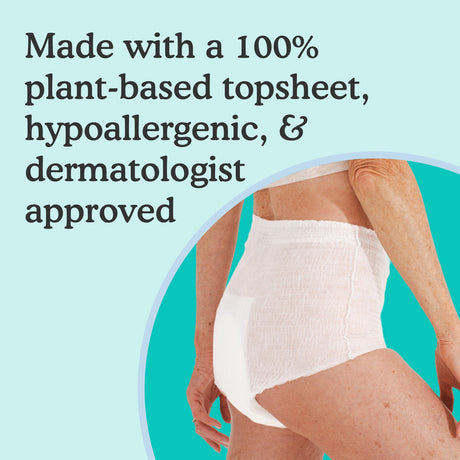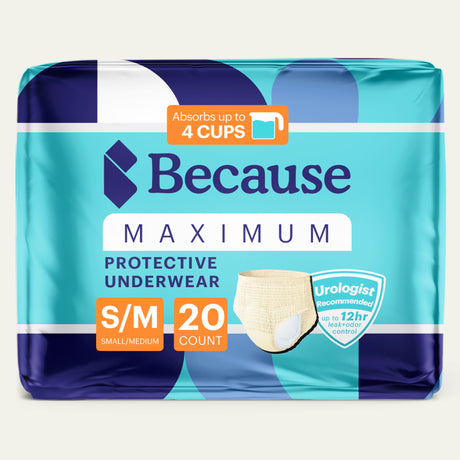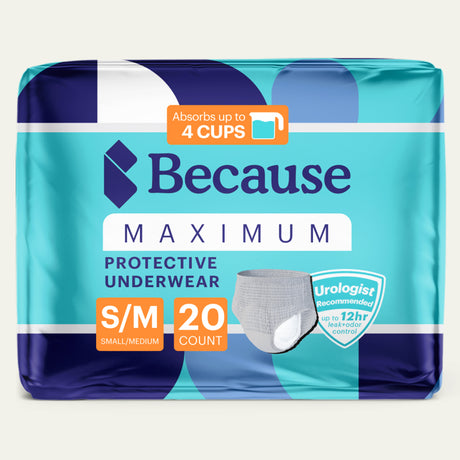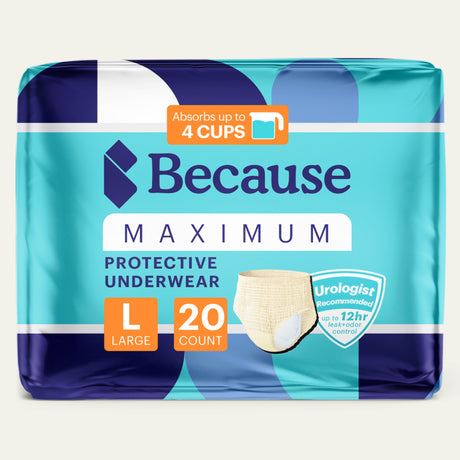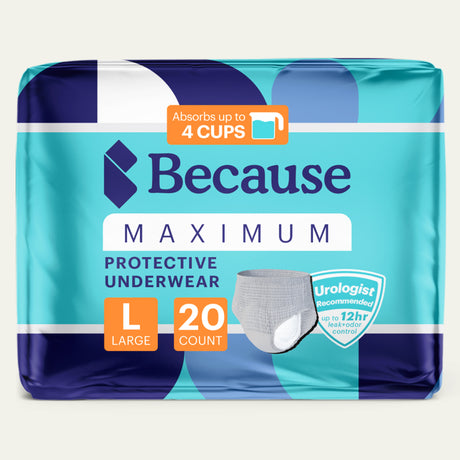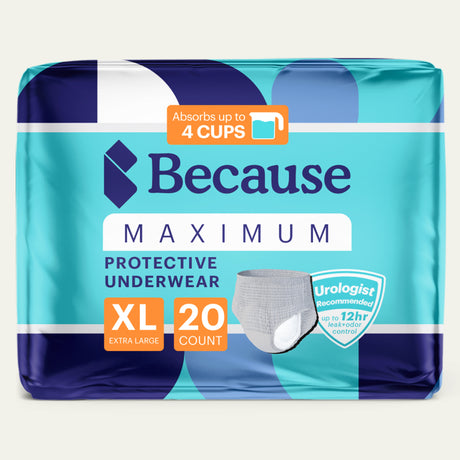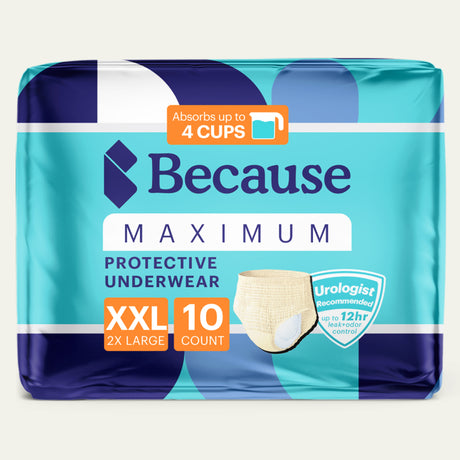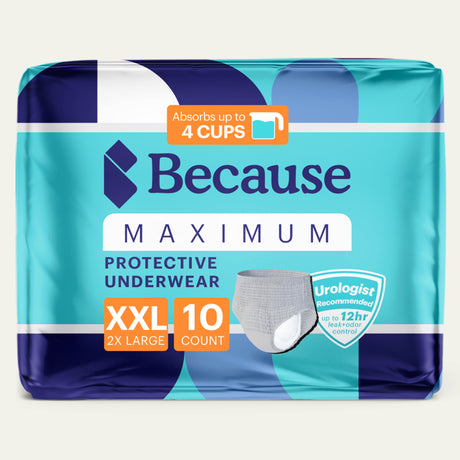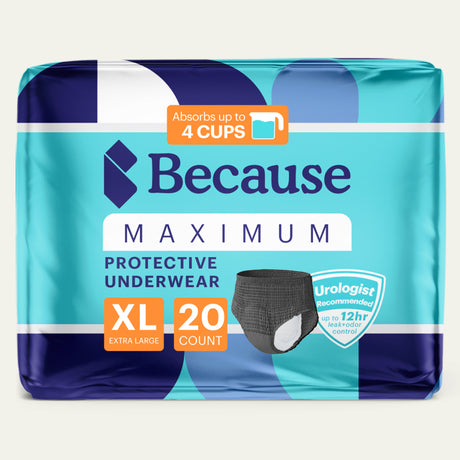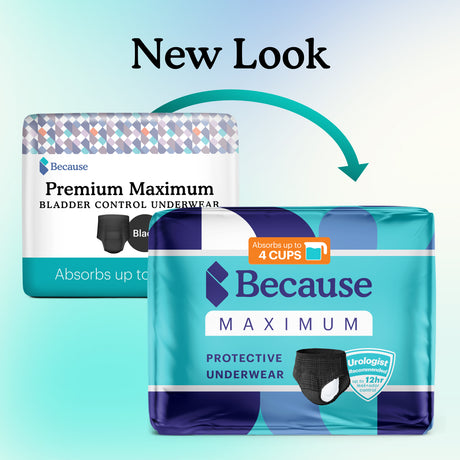Urinary tract infections or UTIs are the second most common type of infection in the U.S. and result in 8 million visits to doctors every year. Around 10 in 25 women and 3 in 25 men will develop at least one UTI during their lifetimes and experience a variety of symptoms as a result.
UTI symptoms often include painful urination, frequent urination, and abdominal pain. But what about bladder control issues? In this post, we’ll explore the connection between urinary incontinence and UTIs, explain the facts, and tell you what you can do to promote a healthy urinary system.

Understanding Urinary Tract Infections (UTIs)
Most urinary tract infections impact the lower urinary tract made up of the bladder and the urethra. The bladder stores urine that travels through the tube-like urethra when you urinate. UTIs happen when bacteria gets introduced into the urinary tract through the urethra.
Often, the bacteria responsible for UTIs is Escherichia coli (E. coli), which is present in feces and may be found around the anus. When E. coli or another type of bacteria enters the urethra, it can attach to the lining of the lower urinary tract, giving rise to an infection. The body then launches an immune response by releasing chemicals that trigger inflammation and cause symptoms of a UTI.
If left untreated, bacteria can travel to more distant parts of the tract, causing a more serious kidney infection. That’s why it’s important to see your healthcare provider for antibiotics when you experience any sign of a urinary tract infection. This is especially true for elderly people and individuals with health issues that make them more prone to infections.
Can a UTI Cause Incontinence?
A UTI can cause a loss of bladder control or incontinence in some people. One study found that postmenopausal women who had recurring UTIs experienced more urine leakage than women who did not. The correlation suggests that there is a higher risk for the leakage of urine in people who have UTIs.

What Causes Incontinence?
Urinary incontinence has many possible causes. The term actually doesn’t apply to a single condition. Rather, there are a few different types of urinary incontinence, each of which has its own cause. Let’s take a quick look at some of the most common types of incontinence and their causes.
Stress Incontinence
Stress incontinence is the most common type of incontinence. It happens when the pelvic floor muscles that support the bladder become weak due to childbirth, pregnancy, surgery for prostate cancer, menopause, or other factors. Due to weak pelvic floor muscles, urine leaks out of the bladder when pressure gets applied to the abdomen. As a result, people with stress incontinence may experience leakage during physical activity like exercise, or when lifting heavy objects, coughing, laughing, or sneezing.
Urge Incontinence
Urge incontinence is another common type of incontinence. The primary symptom of urge incontinence is a strong, sudden urge to urinate that can make it difficult to get to the bathroom in time. Overactive bladder is a type of urge incontinence marked by both a strong urge to urinate and increased urinary frequency. In people with urge incontinence, the bladder muscles contract irregularly, usually due to problems with the nervous system.
Mixed Incontinence
Mixed incontinence is when a person has both urge incontinence and stress incontinence. These individuals experience urine leakage due to abdominal pressure and also the sudden need to urinate that’s common with urgency incontinence.
Overflow Incontinence
In people with overflow incontinence, the bladder doesn’t empty properly due to a blockage, weak pelvic floor muscles, an enlarged prostate, or problems with the nerves that control the bladder muscles. As a result, the bladder becomes overly full and pressure rises within the organ. The increased pressure can push urine out of the bladder through the valve-like urethral sphincter, resulting in urine leakage.
Functional Incontinence
Functional incontinence occurs when a person has bladder leaks because they’re not able to easily get to the bathroom when they experience the urge to urinate. Common causes of functional incontinence include mobility problems or brain disorders that affect a person’s mental state, like Alzheimer’s disease and dementia.
Can Incontinence Cause UTIs?
Research shows that people with urinary incontinence are at a greater risk for UTIs. There are a number of potential reasons for this. Absorbent products used for bladder protection like incontinence pads that don’t fit properly can cause irritation, making infections more likely to occur. Leaks can create a moist environment that allows bacteria to thrive. A lack of proper incontinence hygiene can also increase the chances of microbes entering the urethral opening and causing a bacterial infection.

The Connection Between UTIs and Incontinence
There are a few different reasons why UTIs are one of the possible causes of urinary incontinence. Read on to explore the connection between the two.
Inflammation and Bladder Irritation
Inflammation is part of the body’s natural defense mechanisms. When you get an infection, the inflammatory response helps to fight off bacteria. However, inflammation can also cause bladder problems. If the bladder becomes inflamed, it can be harder for urine to empty completely, leading to a risk of overflow incontinence. In addition, bladder irritation can cause the muscles to contract irregularly, similar to the way they do in urge incontinence.
Weakened Pelvic Floor Muscles
When you have a UTI, inflammation can cause more frequent urination and a strong urge to urinate. If your pelvic floor muscles are weak, you may have difficulty holding your urine in when you experience the urge to go. Since the bladder often doesn’t empty completely during a UTI, it’s also more likely that urine will be present and able to leak out during physical activity.
Age-Related Factors
Older women and men are more prone to urinary tract infections due to changes in the immune system that occur with age. Menopause also causes changes in women’s reproductive organs and hormone levels that increase the risk for UTIs.
Elderly people are more likely to have mobility issues that can make it hard to travel to the bathroom frequently. As a result, older people may be more likely to experience symptoms of urinary incontinence if they need to pee more often due to a UTI.
In older adults, UTIs can also cause temporary cognitive and behavioral changes. Seniors can develop confusion along with other UTI symptoms. As a result, they may not respond to an urgent need to urinate and experience accidents.
Which Type of Incontinence is Most Commonly Associated with a UTI?
Of all the different types of incontinence, urge incontinence is the one most commonly associated with UTIs. In people who don’t usually have bladder control problems, the inflammation associated with an infection can lead to a severe, frequent urge to urinate that results in leaks. Functional and overflow incontinence can also arise due to UTIs, and people with weakened pelvic muscles may be more prone to stress incontinence while they have an infection.

Does UTI-Related Incontinence Go Away After Treatment?
In many cases, UTIs cause only short-term urinary incontinence that resolves after treatment with antibiotic medicine. However, incontinence may become a long-term problem for some people. When this occurs, it is usually because a person already had risk factors for incontinence, such as pelvic floor weakness, an enlarged prostate gland, or nerve damage.
Preventing UTIs and Incontinence
The good news is that there is a lot you can do to reduce your risk for both UTIs and incontinence. Keep reading to find out about lifestyle changes that you can make and treatment options that are available for incontinence.
Practice Proper Hygiene
Good hygiene can help prevent UTIs. These tips can help you improve your hygiene routine to support urinary health:
- Wash your hands before and after you go to the bathroom.
- Always wipe from front to back to reduce the risk.
- Urinate before and after sexual activity.
- Keep the skin of your private area clean, using a gentle foaming wash, a no-rinse spray, or cleansing wipes.
- Change your incontinence products regularly if you wear pads or protective underwear.
It’s also a good idea to switch to breathable cotton underwear and to avoid thongs and G-strings if you’re prone to UTIs. Breathable fabrics can reduce moisture levels to discourage the growth of bacteria, and full-coverage underwear is less likely to cause irritation.
Strengthen Your Pelvic Floor
Strengthening your pelvic floor muscles with Kegel exercises can help improve bladder control every day and when you have a UTI. A physical therapist can teach you the proper way to perform pelvic floor exercises. After a few physical therapy sessions, you can then typically perform the exercises on your own at home.
Try Timed Voiding and Bladder Training
Getting on a regular urination schedule is often a part of a treatment plan for incontinence. With timed voiding and bladder training, you go to the bathroom at set times throughout the day and empty your bladder completely. For example, you might urinate upon waking and then once every three hours until you go to bed for the night. Over time, your body adjusts urine production to this schedule, making leaks less likely to occur. Your doctor can help you develop a timed voiding schedule that is right for your specific needs.
Take Supplements to Promote Bladder Health
Bladder supplements can complement lifestyle changes for UTI and incontinence prevention. Supplements that contain cranberry juice extract and probiotics, like Because UTI Defense Daily Supplement, may help discourage the growth of bacteria in the urinary tract to lower the likelihood of infection. Pumpkin seed and soy germ found in Because Bladder Control Daily Supplement promote a stronger pelvic floor to lessen the risk of leaks, urinary urgency, and nighttime urination.
Pay Attention to What You Eat and Drink
Your diet can have a big impact on urinary health. Follow these tips to revamp yours for UTI prevention and improved bladder control.
- Cut back on alcohol and caffeine, which increase urine production and can irritate the bladder.
- Watch out for acidic, spicy, and fatty foods, which can irritate the bladder.
- Eat fruits, vegetables, and whole grains that contain dietary fiber to promote regularity, since constipation can worsen incontinence.
- Drink enough fluids every day to avoid dehydration, which can contribute to bladder irritation.
- Eat a well-balanced diet and control portion size to support weight loss or maintain a healthy weight, because obesity increases the risk for incontinence.
Medication and Other Medical Interventions
Most people know that doctor visits are important when you have a UTI because antibiotics are necessary to fight the infection and prevent serious complications. However, many people are hesitant to discuss incontinence with their healthcare providers, and this is unfortunate because there are many treatments available for people with bladder control issues.
Some treatment options include:
- Oral medications: Anticholinergics and other drugs can reduce bladder muscle contractions in people with urge incontinence, and there are medications that promote bladder emptying for individuals with overflow incontinence.
- Vaginal estrogen: Topical estrogen creams and suppositories may be prescribed for postmenopausal women prone to UTIs and/or incontinence.
- Barrier devices: Vaginal pessaries and urethral inserts are available for women to insert to absorb urine flow or prevent leaks associated with stress incontinence.
- Botox injections: Injections of Botox into the bladder can reduce contractions and potentially ease symptoms of overactive bladder.
- Sacral nerve stimulation: Sacral nerve stimulation involves an electrical stimulation device that can be implanted at the base of the spine to help regulate nervous system activity and ease symptoms of urge incontinence.
- Urethra bulking agents: Bulkamid and other injectables can increase the strength of your urethra to reduce urine leakage.
- Sling procedures: With this surgical procedure, doctors create a sling out of mesh or human tissue to support the bladder and address stress incontinence.
- Artificial urinary sphincter: Surgeons can perform urethral surgery to install a cuff that prevents urine from exiting the body. When you need to urinate, you press a pump to open the cuff and allow urine to pass through.

Managing UTI Incontinence with Bladder Protection Products
Whether you’re dealing with temporary incontinence due to a UTI or long-term bladder control issues, bladder protection products can help you stay dry and feel more confident. You can choose from bladder control pads and guards that you wear with your regular underwear or incontinence underwear that you use in place of your undergarments.
Incontinence protection comes in men’s and women’s styles and in moderate, maximum, and overnight absorbency levels, so you can choose the type that’s the best match for your symptoms. Take our bladder protection quiz to find out which option is right for you and get a sample pack to try.
If you're struggling with incontinence, join one of our private support groups today!
Women's Incontinence Support Group
Men's Incontinence Support Group
Sources:
American Urological Association. (2016). Understanding UTIs across the lifespan. UrologyHealth Extra, Summer 2016. Retrieved from https://www.urologyhealth.org/healthy-living/urologyhealth-extra/magazine-archives/summer-2016/understanding-utis-across-the-lifespan
Foxman, B. (2002). Epidemiology of urinary tract infections: Incidence, morbidity, and economic costs. The American Journal of Medicine, 113(Suppl 1A), 5S-13S. doi: 10.1016/S0002-9343(02)01054-9
Gupta, K., Hooton, T. M., et al. (2019). International clinical practice guidelines for the treatment of acute uncomplicated cystitis and pyelonephritis in women: A 2019 update by the Infectious Diseases Society of America and the European Society for Microbiology and Infectious Diseases. Clinical Infectious Diseases, 69(5), e82-e110. doi: 10.1093/cid/ciz1003


